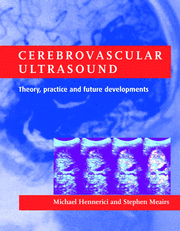Book contents
- Frontmatter
- Dedication
- Contents
- List of contributors
- Preface
- PART I ULTRASOUND PHYSICS, TECHNOLOGY AND HEMODYNAMICS
- PART II CLINICAL CEREBROVASCULAR ULTRASOUND
- (i) Atherosclerosis: pathogenesis, early assessment and follow-up with ultrasound
- (ii) Extracranial cerebrovascular applications
- 14 Carotid and vertebral arteries
- 15 Quantitation and grading of carotid artery stenosis
- 16 Carotid artery pseudo-occlusion
- 17 Standardization of carotid stenosis investigation
- (iii) Intracranial cerebrovascular applications
- PART III NEW AND FUTURE DEVELOPMENTS
- Index
16 - Carotid artery pseudo-occlusion
from (ii) - Extracranial cerebrovascular applications
Published online by Cambridge University Press: 05 July 2014
- Frontmatter
- Dedication
- Contents
- List of contributors
- Preface
- PART I ULTRASOUND PHYSICS, TECHNOLOGY AND HEMODYNAMICS
- PART II CLINICAL CEREBROVASCULAR ULTRASOUND
- (i) Atherosclerosis: pathogenesis, early assessment and follow-up with ultrasound
- (ii) Extracranial cerebrovascular applications
- 14 Carotid and vertebral arteries
- 15 Quantitation and grading of carotid artery stenosis
- 16 Carotid artery pseudo-occlusion
- 17 Standardization of carotid stenosis investigation
- (iii) Intracranial cerebrovascular applications
- PART III NEW AND FUTURE DEVELOPMENTS
- Index
Summary
Introduction and terminology
Pseudo-occlusions of the internal carotid artery (Newton & Couch, 1960) have been described in the literature as ‘a diagnostic trap’ (Gabrielson et al., 1981), and ‘a diagnostic and therapeutical challenge’ (Ringelstein et al., 1983a) referring to both the difficulty in the precise diagnosis and the potentially serious, clinical consequences inherent to these insidious and extreme internal carotid artery stenoses. These consequences do not only refer to the decision of medical surgical treatment, or the timing of carotid endarterectomy, but also to a carefully planned ophthalmological therapy in parallel to vascular surgery (see below). In the 1980s, the false indication for extracranial–intracranial bypass surgery in patients with pseudoocclusions had been another clinical problem (Sekhar et al., 1980).
Several synonyms of the term ‘pseudo-occlusion’ have been suggested in the literature, such as ‘radiographically occluded, anatomically patent carotid artery’ (Clark et al., 1971), ‘nearly occluded internal carotid artery’ (Gabrielson et al., 1981), ‘sténoses athéromateuses pseudo-occlusives’ (Batt et al., 1993), ‘spurious internal carotid hypoplasia’ (Lippman et al., 1970), ‘preocclusive stenoses’ (Hetzel et al., 1993; Mansour et al., 1995), ‘near occlusion of the carotid artery’ (Morgenstern et al., 1997), and, ‘subtotal carotid artery stenoses’ (Goertler et al., 1994). ‘Pseudo-occlusion’ is the most widely used and internationally accepted term which comprises both atheromatous disease, as well as dissections of the internal carotid artery (ICA) and some other, very rare diseases of the ICA.
- Type
- Chapter
- Information
- Cerebrovascular UltrasoundTheory, Practice and Future Developments, pp. 237 - 248Publisher: Cambridge University PressPrint publication year: 2001



